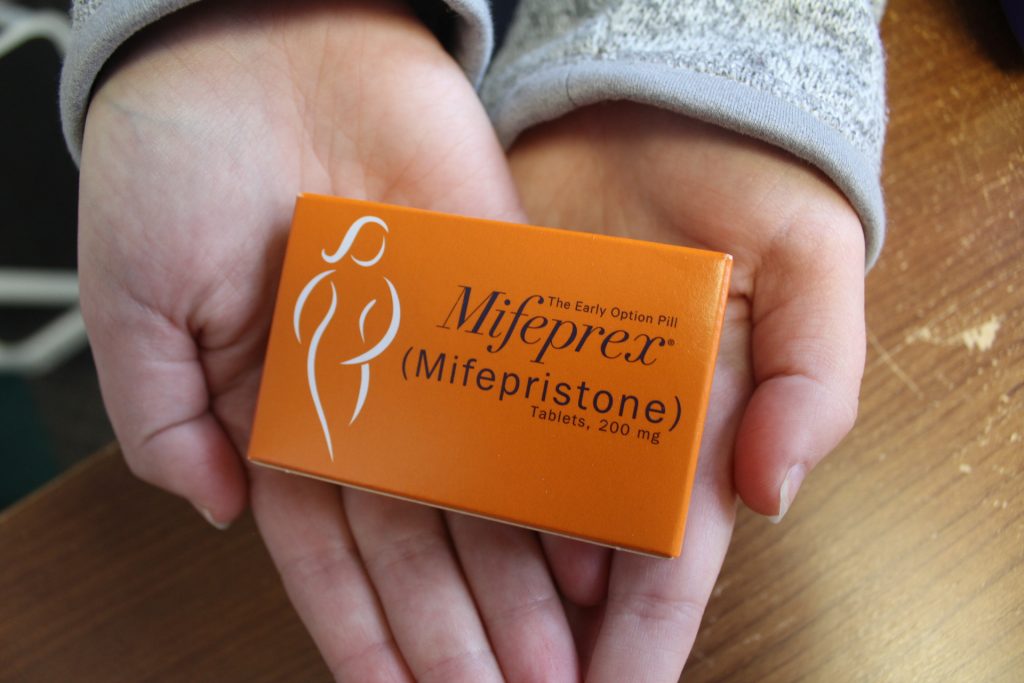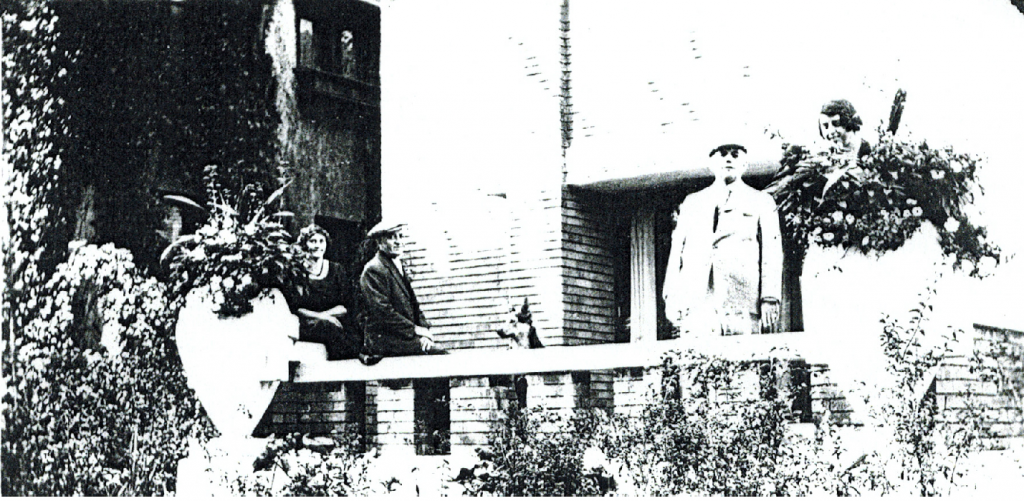1915 Wisconsin Case Could Be Key to Abortion Pill Battle
Texas ruling under review by US Supreme Court cited case involving Milwaukee physician.

Mifepristone. Photo by Flickr user Robin Marty. (CC BY 2.0)
Over the final 20 years of the Roe v. Wade era, while protestors picketed clinics, medication abortion quietly grew to more than half of all procedures, getting mailed to patients, and administered in the privacy of the home.
The dueling rulings of Kacsmaryk and Rice virtually assure a hearing before the U.S. Supreme Court, which issued the requested stay on April 21.
A 1915 Milwaukee Case Cited in Ruling
Kacsmaryk cited Bours v. United States, a 1915 case originating in Milwaukee. Dr. T. Robinson Bours was among over 100 physicians and midwives arrested in a nationwide Federal anti-abortion sweep orchestrated by Taft administration Postmaster General Frank Harris Hitchcock and described at the time as “the most extensive and far reaching ever made by any department of the government.”
The doctor replied by mail that he could undertake a procedure for between $50 and $100. He was convicted and sentenced to two years in Federal Prison. The sentence was stayed, and Bours later won on appeal.
Until the overthrow of Roe v. Wade, this case, like Wisconsin’s 1849 abortion ban, was largely forgotten, and legally moot. But Kacsmaryk made it a key to his decision:
Plaintiffs are within the zone of interests of the Comstock Act. This statute ‘indicates a national policy of discountenancing abortion as inimical to the national life.’ Bours v. United States, 229 F. 960, 964 (7th Cir. 1915) … (the ‘thrust’ of the Comstock Act was ‘to prevent the mails from being used to corrupt the public morals’).
Milwaukee-born Manhattan Lawyer Takes Up the Case
In late April I received an email from Schuyler Frautschi a Milwaukee-born lawyer based in Manhattan, and one of the few attorneys anywhere who had ever heard of Thomas Robinson Bours and his court case before Kacsmaryk revived it:
I read the old Bours appeal back in 2020 (See https://cite.case.law/f/229/960/). So I was gobsmacked to see it featured in Judge Matthew Kacsmaryk’s preliminary nationwide injunction (issued in Texas). His discussion of it is gobbledy-gook.
So, why did he happen to read the Bours appeal back in 2020?
Frautschi grew up in the prominent E. Newberry Avenue home built for Bours in 1921 by architect Russell Barr Williamson. It is still occupied by Schuyler’s mother Pam Frautschi, and I featured it in a 2014 Urban Milwaukee story, along with a mention of Bours and his legal problems, never thinking they would re-enter contemporary jurisprudence. Neither did Frautschi:
… on April 7, I read the story in the New York Times about Judge Kacsmaryk in Texas invalidating the FDA’s mifepristone approval in 2000, and as I often do I clicked through the opinion itself. (Since I’ve worked both in the fields of public health and the law, I like to get into the nitty-gritty of the opinions themselves.) Kacsmaryk refers 3 times to the ancient Bours decision, the first on p. 18: “Likewise, Plaintiffs are within the zone of interests of the Comstock Act. This statute indicates “a national policy of discountenancing abortion as inimical to the national life.” And I immediately thought to myself, “Wait a minute, that’s not what I remember that case standing for!” … I’d just read the case in 2020. And truth be told, I read the case because of you. I’d returned (online) to your 2014 story about my Mom’s home because I was chasing down what leads I could about a dining room set originally from that house, and attributed to Milwaukee interior designer George Mann Niedecken. … Your story was one of many I scoured looking for details on the house. Since you recounted some parts of Dr. Bours’ legal troubles, I went looking for the case. It was not hard to find online. I remember having to read the case several times, because the writing is difficult to parse.
“Nonetheless, I was immediately struck by Judge Kacsmaryk’s take-away about Bours, because that is not what I remembered from the case at all. But in 2020, I would have had no reason to think twice about “a national policy of discountenancing abortion as inimical to the national life,” because Roe, not Dobbs, was the law of the land. By the same token, I’m pretty sure the Dobbs Court did not see this mifepristone case coming.”
Frautschi says the Texas judge “cherry-picked dicta from the 1915 Bours decision about the ‘national policy.'” He notes a lack of distinction between “abortion” and “illegal abortion” in the decision and says that ambiguity must be resolved, as the issue “was never put through the crucible of the sort of adversarial briefing or argument on which courts typically rely to make those sorts of findings.” He adds:
This is part of what they’ll be fighting about all the way up to the Supreme Court.
Article Part Milwaukee History, Part Legal Treatise

Photocopy from Erma K. Bours’ album, in the possession of her niece Joyce Page in 1999. Pictured on the front patio of the house Erma and Dr. Thomas Robinson Bours had built in 1921-22 at what is now 2430 E. Newberry Blvd. are, from right to left, Erma K. Bours, Dr. Thomas Robinson Bours, their German Shepherd “King,” their architect Russell Barr Williamson, and Nola Mae Williamson.
Fired up by the Texas court’s ruling, and with his personal connection to Bours, Frautschi compiled a 2,000-word article on the doctor and his home on Newberry Boulevard which is available as PDF. The story is fully annotated and replete with legal citations. It also offers a very detailed history of T. Robinson Bours, MD, along with many illustrations. Fans of Milwaukee history will find much of interest, and those who closely follow the law will have plenty of material to ponder.
“I’m most interested in helping in whatever little way I might the poor lawyers at the FDA, who have been facing a grueling schedule, and a very uphill battle down in the 5th Circuit. I’d feel bad just standing by watching a religious phalanx attack the administrative state in an area in which I happened to be weirdly well placed to have a sightline. ”
“Assuming the 5th Circuit does not do a complete about-face,” he added, “I suspect exegesis of Bours v. United States will end up in front of the U.S. Supreme Court again, and if so, Milwaukeans’ interest in Bours might be piqued.”
If you think stories like this are important, become a member of Urban Milwaukee and help support real, independent journalism. Plus you get some cool added benefits.
More about the Overturning of Roe v. Wade
- Three Years After the Dobbs Decision, Wisconsin Republicans are Still Trying to Ban Reproductive Freedom - Democratic Party of Wisconsin - Jun 24th, 2025
- On 3rd Anniversary of Roe Being Overturned, Baldwin, Blumenthal, and Murray Lead Senate Dems in a Bill to Restore Abortion Access Nationwide - U.S. Sen. Tammy Baldwin - Jun 24th, 2025
- Support for Abortion Rights Remains Strong in Wisconsin on Third Anniversary of MAGA U.S. Supreme Court Justices Overturning Roe v. Wade - A Better Wisconsin Together - Jun 24th, 2025
- MAGA Wisconsin GOP Pushed to Restrict IVF Access, Reproductive Freedom - Democratic Party of Wisconsin - Feb 27th, 2024
- Families Are Losing Access to IVF Because of Donald Trump - Democratic Party of Wisconsin - Feb 23rd, 2024
- Planned Parenthood Seeks Wisconsin Supreme Court Ruling On Abortion - Hope Kirwan - Feb 22nd, 2024
- PPWI Asks Wisconsin Supreme Court to Protect Abortion Rights - Planned Parenthood of Wisconsin - Feb 22nd, 2024
- Wisconsin Democrats on Donald Trump’s National Abortion Ban - Democratic Party of Wisconsin - Feb 16th, 2024
- How Did Dobbs Decision Affect State’s Birth Rate? - Bridgit Bowden - Jan 2nd, 2024
- Gov. Evers Slams Republicans’ New Effort to Restrict Reproductive Healthcare in Wisconsin - Gov. Tony Evers - Dec 21st, 2023
Read more about Overturning of Roe v. Wade here
Plenty of Horne
-
Villa Terrace Will Host 100 Events For 100th Anniversary, Charts Vision For Future
 Apr 6th, 2024 by Michael Horne
Apr 6th, 2024 by Michael Horne
-
Notables Attend City Birthday Party
 Jan 27th, 2024 by Michael Horne
Jan 27th, 2024 by Michael Horne
-
Will There Be a City Attorney Race?
 Nov 21st, 2023 by Michael Horne
Nov 21st, 2023 by Michael Horne




















